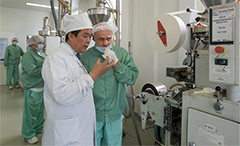China issues first white paper on traditional Chinese medicine
2016-12-06
Xinhua
The Chinese government published its first white paper on traditional Chinese medicine (TCM) on Dec 6, detailing policies and measures on TCM development and highlighting its unique value in the new era.
“TCM has created unique views on life, on fitness, on diseases and on the prevention and treatment of diseases during its long history of absorption and innovation,” said the white paper, Traditional Chinese Medicine in China, published by the State Council Information Office.
As ideas on fitness and medical models change and evolve, traditional Chinese medicine has come to underline a more and more profound value, according to the document.
Boasting the establishment of a TCM medical care system covering both urban and rural areas in China, the white paper said there were 3,966 TCM hospitals, 42,528 TCM clinics and 452,000 practitioners and assistant practitioners of TCM across the country by 2015.
In addition to making contribution to the prevention and treatment of common, endemic and difficult diseases, TCM has played an important role in the prevention and treatment of major epidemics, such as SARS, HIV/AIDS, and Hand, Foot and Mouth Disease, it said. The TCM also played an important role in the reform of the medical care system, according to the white paper.
“With relatively low cost, TCM has contributed rather a higher share of services in relation to the resources it is entitled to,” it said.
The medical care services provided by TCM institutions in the national total increased from 14.3 percent to 15.7 percent from 2009 to 2015, official statistics show.
In 2015, out-patient expenses per visit and in-patient expenses per capita at public TCM hospitals were 11.5 percent and 24 percent lower than those at general public hospitals, respectively.
China has initially established a modern Chinese medicine industry based on the production of medicinal materials and industrial production and tied together by commerce, said the white paper while noting the rapid development of the TCM pharmaceutical industry.
A number of laws and regulations have been enacted and implemented on strengthening the protection of TCM wild medicinal resources; and artificial production or wild tending have been carried out for certain scarce and endangered resources, according to the document.
To date, 60,000 TCM and ethnic minority medical drugs have been approved, and 2,088 pharmaceutical enterprises that have been approved by the Good Manufacturing Practice (GMP) of Medical Products are manufacturing Chinese patent medicines.
In 2015, the total output value of the TCM pharmaceutical industry was 786.6 billion yuan ($114.21 billion), accounting for 28.55 percent of the total generated by the country’s pharmaceutical industry, and becoming a new source of growth in China’s economy.
Elaborating the country’s policies and measures to promote TCM development, the white paper said China has made the TCM development “a national strategy.”
A series of major policy decisions have been made and a number of plans have been adopted to promote TCM development since the Communist Party of China (CPC)’s 18th National Congress in 2012.
In 2015, the executive meeting of the State Council, or the Cabinet, approved the draft Law on Traditional Chinese Medicine and submitted it to the top legislature for deliberation and approval, intending to provide a sounder policy environment and legal basis for TCM development.
In 2016, the CPC Central Committee and the State Council issued the Outline of the Healthy China 2030 Plan, a guide to improving the health of the Chinese people in the coming 15 years.
In the same year, the State Council issued the Outline of the Strategic Plan on the Development of Traditional Chinese Medicine (2016-2030), which made TCM development a national strategy, with systemic plans for TCM development in the new era.
The white paper described these plans as “a grand blueprint” that focuses on the full revitalization of TCM, saying they ushered in a new era of development for TCM.
Stressing the innovative development of TCM for health preservation, the white paper said China aspires to enable every Chinese citizen to have access to basic TCM services by 2020, and make TCM services to cover all areas of medical care by 2030.
Meanwhile, the TCM is going global, the white paper noted, saying TCM has been spread to 183 countries and regions around the world.
According to the World Health Organization, 103 member states have given approval to the practice of acupuncture and moxibustion, 29 have enacted special statutes on traditional medicine, and 18 have included acupuncture and moxibustion treatment in their medical insurance provisions.


